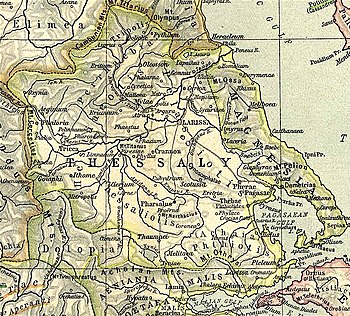39°35′25″N 22°55′13″E / 39.5904°N 22.9204°E / 39.5904; 22.9204

Casthanaea or Casthanea or Kasthanaia or Kasthaneia (Greek: Κασθαναία) or Castanea or Kastanaia (Κασταναία) was a town and polis (city-state) of Ancient Magnesia, at the foot of Mount Pelium, with a temple of Aphrodite Casthanitis. It is mentioned by Herodotus in his account of the terrible storm which the fleet of Xerxes I experienced off this part of the coast. and by Pliny. It was from this town that the chestnut tree, which still abounds on the eastern side of Mt. Pelium, derived its name in Greek and the modern languages of Europe. Its location is at the modern village of Keramidi.
References
- Strabo. Geographica. Vol. Strab. ix. pp.438, 443. Page numbers refer to those of Isaac Casaubon's edition.
- Stephanus of Byzantium. Ethnica. Vol. s.v.
- Mogens Herman Hansen & Thomas Heine Nielsen (2004). "Thessaly and Adjacent Regions". An inventory of archaic and classical poleis. New York: Oxford University Press. p. 719. ISBN 0-19-814099-1.
- Herodotus. Histories. Vol. 7.183, 184, 188.
- Pliny. Naturalis Historia. Vol. 4.16.9.
- "Essai monographique sur le châtaignier", Édouard Lamy, 1860 p.4.
- Richard Talbert, ed. (2000). Barrington Atlas of the Greek and Roman World. Princeton University Press. p. 55, and directory notes accompanying. ISBN 978-0-691-03169-9.
- Lund University. Digital Atlas of the Roman Empire.
![]() This article incorporates text from a publication now in the public domain: Smith, William, ed. (1854–1857). "Casthanaea". Dictionary of Greek and Roman Geography. London: John Murray.
This article incorporates text from a publication now in the public domain: Smith, William, ed. (1854–1857). "Casthanaea". Dictionary of Greek and Roman Geography. London: John Murray.
This article about a location in ancient Thessaly is a stub. You can help Misplaced Pages by expanding it. |